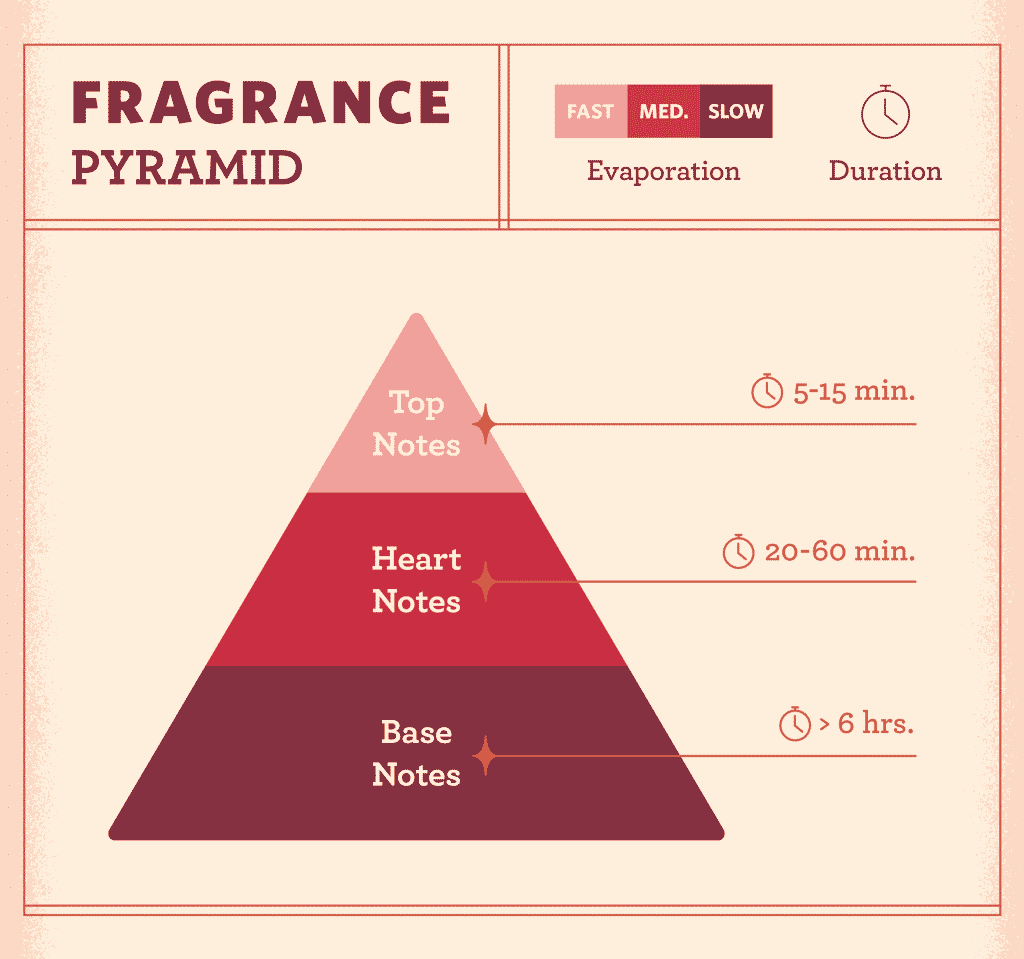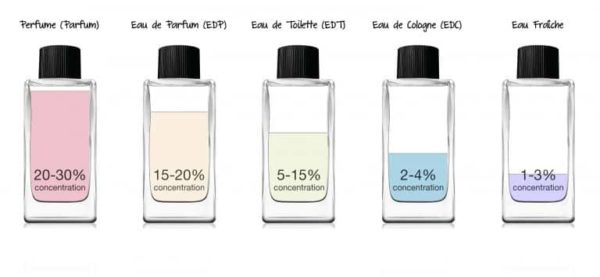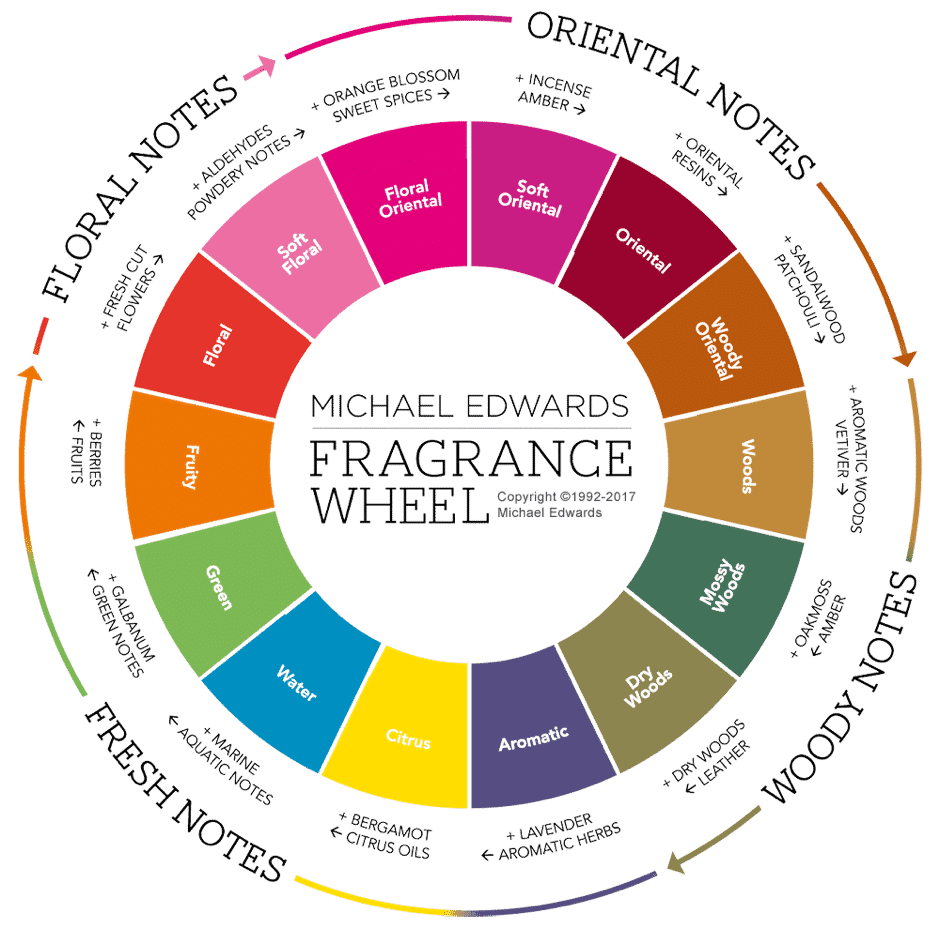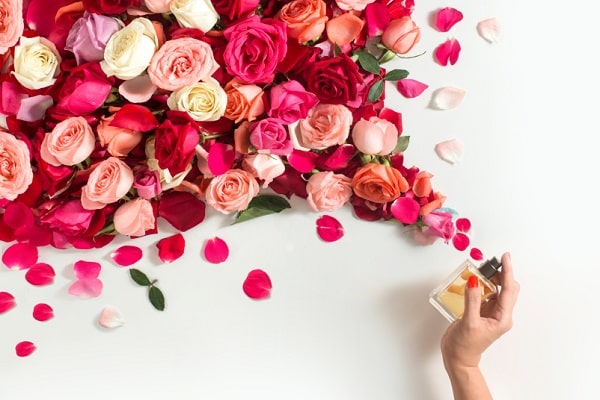Understanding Perfume Notes, Concentration and Fragrances
“A great perfume is a work of art, it can lift our days, haunt our nights and create the milestones of our memories. Fragrance is liquid emotion. And that never goes out of fashion.”
- Michael Edwards: The Perfume Expert’s Expert
Shopping for perfume can be overwhelming if you don’t know what you are looking for. Here we aim to guide you through the process by giving you a clearer understanding of perfume so that you can make the best possible choice. We discuss perfume notes, perfume concentration, and fragrance families. Lastly, we list common perfumery terms to further demystify the subject.
Perfume has the power to arouse reminiscences, moods and emotions in a way that our other senses cannot. Receiving a compliment on how marvelous you smell is a feeling that takes some beating.
1. Understanding Fragrance Notes

Each perfume comprises of layers of scents to form its distinctive bouquet. You can visualize these layers as a fragrance pyramid (as shown above). The layers are called fragrance notes. A fragrance is made up of three types of scents in different proportions: firstly the top notes (30%), then the middle notes (50%), and lastly the base notes (20%).
Let me explain:
Top notes (also called head notes) are what you smell first, and they fade faster given their light molecular structure. They give the first impression of the perfume blend. It is crucial that the top notes entice you, but also effortlessly evolve into the heart of the fragrance. The scents of the oils in this note will tend to be light, fresh, and uplifting. Common fragrance top notes include citrus (lemon, orange zest, bergamot), light fruits (grapefruit, berries) and herbs (clary sage, lavender).
Middle notes (also referred to as heart notes) surface as the top notes dissipate and these are considered the core of your fragrance. These oils will give the full body to the perfume blend and have a strong effect on the base notes. Not quite as volatile as the top notes, middle notes will take a little longer to surface (typically 20-60 minutes after application). Generally these will be warm and comforting scents. Common fragrance middle notes include geranium, rose, lemongrass, ylang-ylang, lavender, coriander, nutmeg, neroli and jasmine.
Base notes are what help the middle notes last longer; they accentuate and extend the longevity of the middle notes. They will be noticeable for quite a while and they also slow down the evaporation of the oils from the top two notes. These notes provide complexity and support the middle notes. This is the most prominent part of any fragrance. Base notes will generally be very rich and can also be relaxing in nature. Common fragrance base notes include cedarwood, sandalwood, vanilla, amber, patchouli, oakmoss and musk.
2. Perfume Concentration
Perfume concentration refers to the strength of a fragrance, or more specifically, to how much high grade alcohol and/or water has been added to the fragrance oils.

2.1 Parfum
Concentration of perfume oils: 20% to 30%
Parfum has the largest fragrance concentration. The longest lasting of all scents, a parfum usually lasts between 6 to 8 hours. Parfum generally also commands the highest price. It contains less alcohol which is better for sensitive skin.
If you love a fragrance, try the parfum as it is usually the most opulent and multifaceted version.
2.2 Eau de Parfum
Concentration of perfume oils: 15% to 20%.
This is the typical dilution level for fragrances, with between 15 and 20 percent oil. Eau de Parfum tends to be the most conspicuous to those around you. This makes them great for date nights. They are however no good for long periods of time spent in the heat, as this tends to make them smell stronger.
On average, Eau de Parfum will last for 4 to 5 hours and being less expensive it is one of the most prevalent and also the most appropriate for everyday wear.
2.3 Eau de Toilette
These are your go-tos for day-to-day or warmer weather. They usually deliver a daintier, less complicated scent. Often positioned as second-rate to EDPs, that is actually not the case. They each have their own purpose, with EDT often being a great entry level choice.
Concentration of perfume oils: 5% to 15%.
EDT is less expensive than EDP and is one of the most popular fragrance types. It will last between 2 to 3 hours. The term eau de toilette derives from the French term "faire sa toilette" which means getting ready. It is most often applied to the skin after bathing or shaving.
2.4 Eau de Cologne
Concentration of perfume oils: 2% to 4%
Eau de Cologne has a much lower concentration of fragrance and is therefore cheaper. This scent has a lasting power of only around two hours. EDC is often presented in bigger bottles as more of the fragrance is necessary for use. Originally it referred to a traditional recipe using herb and citrus notes.
If you are looking for something fresh and light then EDC is a great choice. The beauty of EDC lies in its minimalism.
2.5 Eau de Fraiche
Concentration of perfume oils: 1% to 3%
Eau de Fraiche has a lower price due to the low percentage of essential oils it contains. It does not however contain a larger amount of alcohol with the extra ingredient most often being water. The term, "eau fraiche" translates to fresh water. It is comparable to EDC in that the scent generally lasts for up to two hours.
Considered the beer shandy of the fragrance world, it is very popular among those who cannot afford the sometimes exorbitant cost of parfum.
2.6 Body Splash/Aftershave
Aftershave is a liquid product containing an antiseptic agent to prevent the infection of cuts, as well as ease skin irritation. Some aftershaves make use of fragrance or essential oils to enrich the scent.
Marketed to men, aftershave products reduce the number of steps in a skincare routine, and forms part of a ritual for many people. They are made to be applied all over as well as repeatedly, making them perfect for the outdoors or the gym.
3. Fragrance Notes Make Up Fragrance Families
The next phase to making the perfect perfume choice is to understand the different fragrance families on which each perfume is based.
The famous "Fragrance Wheel" created by Michael Edwards classifies fragrance notes into four categories: floral notes, oriental notes, woody notes, and fresh notes. Each category is called a fragrance family according to the scent notes contained within.



Notes
3.1 Floral
Undoubtedly the most popular choice and the broadest, floral fragrance notes comprise of the scent of one or many flower varieties. Floral scents are romantic. They are flirty and girlish and range in concentration from being light and delicate, to more complex and intense. Floral fragrances often contain notes such as roses, jasmine, lilies and peonies. Think of perfumes with gardenia notes. Men’s floral colognes usually use orange blossom, giving them a charming quality.
3.2 Oriental
Oriental fragrance notes are warm, sweet and spicier with suggestions of vanilla, cardamom, cinnamon and clove alongside the likes of jasmine, orchid and orange blossom. Originating from mysterious parts of the world and made from spices, this is a more luxurious fragrance family. Oriental fragrances range from floral oriental to soft oriental and woody oriental.
3.3 Woody
Preferred by men, these scents often have light top notes with spicier base notes of wood-based smells like cedarwood, sandalwood note, vetiver or amber, providing an air of sophistication and enigma to those wearing them. Women favor the woody notes for evenings. Woody scents can be mossy with an earthy, sweet undertone, or dry - often with a smoky, leathery smell to them.
3.4 Fresh
Fresh fragrance notes are usually made up of citrus, water or green notes. This means they have refreshing, zesty and vibrant smells. Citrus-based fragrances are usually created with lemon, mandarin and bergamot. Water fragrances are made with aquatic notes like sea spray. Fresh green fragrances are often reminiscent of herbal and leafy scents and have a crisp, uplifting smell. They can sometimes be paired with notes of lavender, rosemary or basil.
Perfumery Terms
- Abelmosk: Also known as Musk Mallow and cultivated forits seeds, which are usually referred to as ambrette.
- Absinthe: A strong herbal liqueur distilled with herbs like anise, licorice, hyssop, veronica, fennel, lemon balm, angelica and wormwood.
- Absolute: Also known as essence, this is the material extracted from a plant or flower using one of a number of solvents. This is the strongest material that can be extracted from a plant or flower.
- Accord: A combination of two or more scents creating an entirely different aroma. The personality of a fragrance is determined by its basic accord.
- Agar Wood: Obtained from the Aquilaria tree, and also called Oud or Aloes wood. The tree, when attacked by a common fungus, produces an aromatic resin that has long been used in the Middle East as a source of incense and perfume. Modern oud fragrances frequently use synthetic substitutes as the agar wood tree is considered endangered in the wild due to over-harvesting.
- Aldehyde: An artificial version of an accord.
- Amber: A musky scent developed by using plant extracts such as wood or resin. Find out more about amber perfumes.
- Ambergris: Originating from the sperm whale and one the most lavish ingredients in the perfume world. In modern perfumery ambergris is
usually of synthetic origin. - Ambrette: The oil obtained from these seeds has a musklike odor and is frequently used as a substitute for true musk.
- Ambroxan: A synthetic compound often used as an alternative to natural ambers such as Ambergris.
- Animalic: Animal-derived ingredients such as civet, ambergris, musk, and castoreum. Usually reproduced synthetically in modern perfumery. Often strong and unpleasant in their concentrated form, in smaller amounts these notes provide depth to a fragrance.
- Anosmia: The inability to detect certain notes or odors. It is usually used to describe a condition whereby one has become acclimated to a particular scent.
- Apocrine Sweat Glands: The glands on the human body that give you your unique scent, which can interfere with - or enhance - the scent of perfumes you wear.
- Aquatic: Characterized by marine notes like algae, salt, and fresh sea air.
- Aromatic: An olfactive family within men’s fragrances, aromatics tend to feature green and herbaceous notes with a touch of freshness.
- Aromatic Compound: Any fragrant chemical derived from benzene, a hydrocarbon found in petroleum.
- Attar: Any essential oil distilled from flowers. Attar is the English form of "itr", the Arabic word for fragrance or perfume.
- Baies Rose: Pink pepper from the tree Schinus Molle, also known as the Peruvian or California pepper tree. These are actually dried berries and not ‘true’ peppercorns.
- Balsam of Peru: A tree resin from Central America, so named because it was historically shipped from Peru. Balsam of Tolu is from a closely related species of tree grown farther south; both resins are said to smell like vanilla and cinnamon.
- Balsamic: A sweet accord offering rich and warm qualities to combinations. The balsamic influence is most commonly found in Oriental fragrances.
- Bay Rum: A traditional men’s cologne made from the leaves of the Bay Rum tree distilled in a mixture of rum and water.
- Benzoin: A balsamic resin from the Styrax tree having a sweet odor.
- Bergamot: The essential oil from the rind of the Citrus aurantium, an inedible fruit that looks like a small orange.
- Black Pepper: Made from not-quite-ripe peppercorns, this is an intensely fragrant oil which delivers a burst of heat while remaining surprisingly fresh and woody.
- Bouquet: A combination of floral notes.
- Calone: A popular synthetic aldehyde used for creating an aquatic sea-breeze scent.
- Camphor: This is a bracing, potent note which can conjure up mothballs, or cough mixture. It comes from the camphor tree but is also present in rosemary and eucalyptus.
- Cashmeran: An chemical with a spicy, ambery, musky, floral odor. Meant
to add a powdery, velvet nuance that invokes the smell or feel of cashmere. - Cassie: A floral note from acacia farnesiana (sweet acacia), a member of the mimosa family.
- Cassis: The French word for “blackcurrant” often used when describing the note.
- Castoreum: A musky leather note that was originally extracted from beavers, it is now a synthetic compound.
- Champaca: A flowering tree of the magnolia family, originally found in India, also called the "Joy Perfume tree" as it was one of the main floral ingredients in that perfume.
- Choya Nakh: A smoky scent made from roasted seashells.
- Chypre: Pronounced "sheep-ra", it is one of the olfactory families. It is based on citrus notes, mosses, patchouli and labdanum. It smells captivating but elegant and can be described as passive and detached.
- Civet: A fox-like creature related to the mongoose whose musk was a highly sought-after stabilizing agent. However, modern interpretations of this note are often synthetic in nature.
- Clary Sage: A herb of which the essential oil is described as smelling sweet
to bittersweet, with nuances of amber, hay and tobacco. - Cloying: A sickly sweet note that can be overly rich.
- Coffret: A collection or box set that often contains either smaller sample sizes of several fragrances, or a fragrance and its accompanying bath products.
- Compound: The concentrated fragrance mixture before it is diluted to make the finished perfume. Also called perfume oil.
- Coumarin: An organic chemical extracted from the Tonka Bean.
- Cuir: The French word for leather often used in fragrance names.
- Cypriol: An essential oil derived from the roots of Cyperus Scariosus, (Indian Papyrus).
- Distillate: A product of distillation. For example, lavender oil is the distillate of the fresh, blooming lavender plant.
- Dry Down: The final phase of a fragrance, which emerges several hours after application. Perfumers evaluate the base notes and the tenacity of the fragrance during this stage.
- Earthy: Notes that give the impression of earth, soil, the forest floor, mold and moss.
- Elemi: A resin similar to frankincense but lighter than other amber notes. Its smell is green and citrusy, which is often likened to fresh pine.
- Essential Oil: The highly concentrated, aromatic essences of plants obtained by distillation or expression.
- Evanescent: A fleeting or quickly vanishing note or fragrance.
- Extrait (Extract): An alternative name for alcoholic perfumes, extraits contain 15 to 45 percent perfume compound in alcohol.
- Factice: A perfume bottle made for commercial display only. The contents are not actually perfume.
- Fixative: An ingredient added to perfume to make it last longer.
- Flanker: A fragrance release related to a popular or distinctive pre-existing fragrance, a flanker is usually similar to the first fragrance but with one or two key alterations.
- Fougère: French for “fern”, it has a sharp herbaceous and woody scent. A distinctly masculine genre.
- Frangipani: The common name for Plumeria, a tropical flower. Frangipani is also known as West Indian Jasmine.
- Frankincense: An aromatic gum resin of the Boswellia tree which is usually burned as incense. It smells smokey and woody but is also slightly sweet and citrusy.
- Galbanum: A gum resin with a ‘green’ smell.
- Gourmand: A gourmand fragrance is one that primarily evokes food, usually dessert. Gourmand fragrances are the most disruptive type - you either love them or hate them. Common notes include vanilla, chocolate, burnt sugar, and caramel.
- Green: A fresh and energetic making fragrance that feels crispy and sharp. Found most frequently in summer & sporty fragrances.
- Guaiacwood: A smokey and honey sweet wood that is reminiscent of tobacco.
- Hedione: An chemical said to have a soft jasmine aroma; also appreciated for its diffusive effect.
- Heliotrope: In perfumery it refers to the flowers of the family heliotropium, which have a strong, sweet vanilla-like fragrance with undertones of almond.
- Herbaceous: A scent that is natural, cool, leafy or hay-like, such as chamomile or clary sage.
- Hesperidia: A general term for citrus oils.
- Incense: Smoky, slightly sweet, deep and rich.
- Indole: A chemical compound which smells floral at low concentrations, but fecal at high concentrations. Also found naturally in some floral scents such as jasmine, tuberose and orange blossom.
- Ionones: Highly-valued synthetic chemicals used in small amounts in many floral, green, and woody perfumes. They produce a scent similar to violet or iris.
- Karo Karounde: A flowering shrub from Africa. The scent is somewhat similar to jasmine, but woodier, spicier and more herbal.
- Labdanum: A gum musk extracted from the rockrose bush, it has a sweet and musky aroma that is often used as an alternative to animalic notes.
- Leather: Can be described as the smokiness related to old leather. Leather notes play a significant role in the context of complex florals.
- Licorice: A shrub native to Europe and Asia. The roots are used for candy and
flavoring, and are said to be 50 times sweeter than sugar. - Longevity: How long a fragrance will last after having been applied.
- Metallic Notes: Refers to the scent produced by metal or minerals which smell slightly earthy, cool, clean and sharp.
- Mossy: Fragrances with earthy, aromatic forest scents.
- Muguet: French for Lily of the Valley.
- Musk: Originally extracted from animals, musks are now almost exclusively synthetic. They feature a strongly animalisc character but can sometimes be sourced from plants such as labdanum.
- Myrrh: A famous gum resin with a slightly earthy scent reminiscent of black licorice.
- Nag Champa: A perfume oil originally made in the Hindu and Buddhist monasteries of India and Nepal and used to perfume incense. Traditionally made from a sandalwood base, to which are added a variety of flower oils, including that from the flower of the Champaca tree.
- Nose: A perfumer.
- Neroli: An oil extracted from sweet orange blossom through steam distillation. It smells sweet but can be much sharper than orange blossom.
- Oak Moss: Oak Moss is a lichen that features an earthy and woody smell.
- Oceanic: These scents use a blend of synthetic compounds to evoke natural aromas such as mountain air, ocean spray, or clean linen.
- Opoponax: Also known as ‘sweet myrrh’ and ‘bisabol myrrh’. It has a sweet, balsam-like, lavender-like fragrance when used as incense.
- Orris: The “butter” from the dried roots of the iris flower, orris is a prized and expensive perfume ingredient that creates a rich, earthy, carroty, powdery note in fragrances.
- Osmanthus: A flowering tree native to China. It is valued for its delicate fruity apricot aroma.
- Oud Or oudh: The Arabic word for wood; it usually refers to wood from the Agar tree.
- Ozonic: Deriving most usually of cucumber and/or melon these fragrances are meant to mimic the smell of fresh air after a thunderstorm.
- Patchouli: A bushy herb that has a musky yet earthy odor. It is sweet and smells like much like wet soil, which makes it reminiscent of the dewy forest when combined with oak moss.
- Petitgrain: Similar to Neroli except that the leaves and twigs are used to create the oil as well as the orange blossom. This creates a woodier and more herbaceous aroma.
- Pikaki: A form of jasmine (Jasmine Sambac) grown in Hawaii.
- Pillar Fragrance: A standalone fragrance meant to hold up the brand, that is, it is not a flanker.
- Powdery: A baby-powderish scent effect, produced when a heavier sweet or woody note is blended with a lighter note such as citrus, fruity or light green note.
- Projection: A term for how far away from the wearer another person has to be to smell the perfume.
- Resinoids: Extracts of resinous gums, balsams, resins or roots commonly used as fixatives in perfumes.
- Sandalwood: One of the oldest sources of perfumes and incense, Sandalwood smells like a warm and powdery wood with a creamy finish.
- Sillage: The trace of scent left behind by a perfume - it is pronounced “see-yazh,” Like when someone steps off an elevator and you catch a whiff of their sillage.
- Soliflore: A perfume based on a single flower.
- Solvent: Often alcohol, the solvent of a fragrance is the base used to contain the aromatic oils and compounds. It accounts for the majority of the content in a perfume bottle.
- Stability: Refers to how long a scent lasts in the bottle, or when exposed to elements such as heat, light and air.
- Tagetes: Marigold.
- Tonka Bean: Although now illegal due to its toxicity in large doses, the tonka bean is a sweet and earthy gourmand note.
- Vanilla: Derived from the seed pod of the vanilla orchid, a flowering vine which is native to Mexico.
- Vetiver: An ingredient of ancient perfumes referred to as "the oil of tranquillity". Vetiver is described as smelling warm and parched while carrying earthy, woody scents, leather, balsamic and smoky notes.
- Volatility: Volatility is how fast a particular note or its ingredients evaporate after being sprayed. The various levels of volatility in a fragrance is what produces the dry-down.
- Ylang-ylang: Somewhat similar to jasmine, Ylang-Ylang is an oil sourced from an Indonesian flower.

